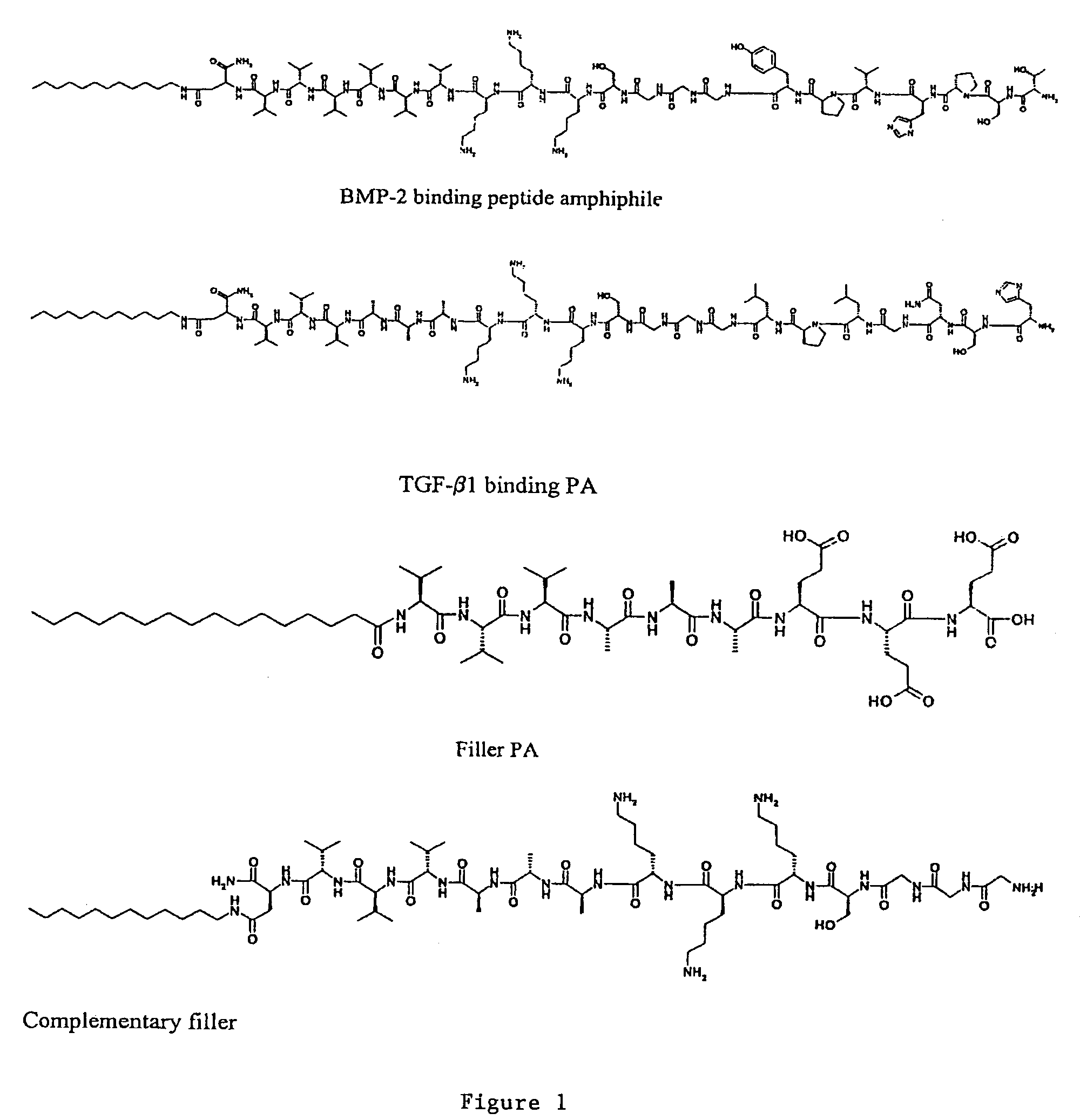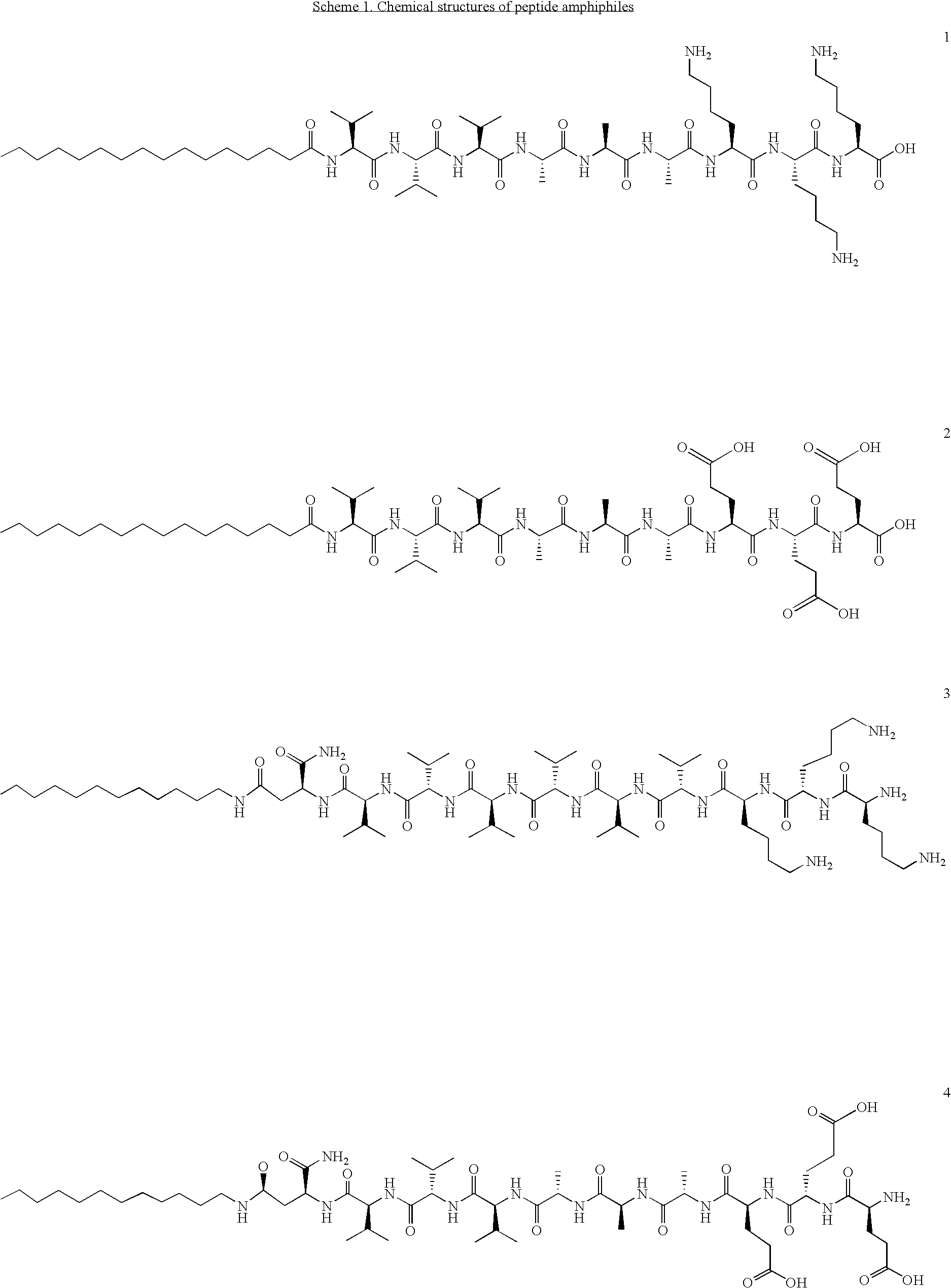Self-assembling peptide amphiphiles and related methods for growth factor delivery
a technology of growth factor and amphiphiles, which is applied in the direction of peptides, drug compositions, tissue culture, etc., can solve the problems of ineffective growth factor interaction and non-specificity of pa compounds, and achieve the optimization of stem cell differentiation, optimizing binding strengths, and modulating bioavailability.
- Summary
- Abstract
- Description
- Claims
- Application Information
AI Technical Summary
Benefits of technology
Problems solved by technology
Method used
Image
Examples
example 1
[0052]Four PAs, two with a triple lysine sequence (1 (SEQ ID NO:3), 3 (SEQ ID NO:5) and two with a triple glutamic acid sequence (2 (SEQ ID NO:4), 4 (SEQ ID NO6)), were prepared (Scheme 1). PAs 1 and 2 were prepared by standard Fmoc solid-phase peptide techniques using a preloaded Wang resin followed by alkylation with palmitic acid with 2-(1H-benzotriazole-1-yl)-1,1,3,3-tetramethyluronium hexafluorophosphate (HBTU) as a coupling reagent. The amphiphile was cleaved from the resin with a mixture of 95% trifluoro-acetic acid (TFA), 2.5% water and 2.5% tri-isopropylsilane (TIS). For the synthesis of peptide amphiphiles 3 and 4, amino acid 7 was synthesized according to Scheme 2. N-Carbobenzyloxy-L-aspartic anhydride was reacted with dodecylamine, yielding fatty acid amino acid 5. The CBz group was then removed by catalytic hydrogenation to yield 6, followed by Fmoc-protection of the amine. This synthesis proceeds readily on a 5 gram scale. Product 7 was then coupled to a rink resin usi...
example 1a
[0054]N-dodecyl-2-carbobenzyloxyamino-succinamic acid (5). N-Carbobenzyloxy-L-aspartic anhydride (1 mmol) was dissolved in 50 mL methylene chloride, followed by the addition of 1.05 eq of dodecylamine and 1.1 eq of triethylamine. The reaction was capped to prevent evaporation, and stirred for 12 hours. When no trace of starting material could be detected by thin layer chromatography (TLC) (CH2Cl2, 5% MeOH), the reaction was quenched with 20 mL 1N hydrochloric acid followed by extraction with chloroform (5×). The organic layer was dried over magnesium sulfate, and 7 was obtained as a white solid (yield 97%).
[0055]1H NMR (CDCl3): δ 0.8 (t, J=8.5 Hz, 3H, tail CH3), 1.18 (s, 18H C9H18 tail), 1.48 (br-s, 2H, CONHCH2), 2.68 (s, 2H, CONHCH2CH2), 3.15 (br-s, 2H, Asp Hβ), 4.49 (m, 1H, Asp Hα), 5.12 (s, 2H, PhCH2O), 7.28 (s, 5H, Ph). 13C (DMSO-D6) δ 14.6, 22.8, 29.4, 29.6, 29.7, 32.0, 52.2, 56.7, 66.1, 128.4, 129.0, 137.7, 156.5, 171.1, 172.5. ESI MS: m / z: 435.4 (MH+).
example 1b
[0056]2-amino-N-dodecyl-succinamic acid (6). In 100 mL ethanol, 100 mmol of 7 was dissolved and transferred to a reaction vessel containing Pd and C (10% by weight). The vessel was then placed under hydrogen (35 Torr) for 3 hours. The reaction mixture was filtered over celite, and the product obtained as a white solid after evaporation to dryness under reduced pressure. Yield 95%.
[0057]1H NMR (CD3CN): δ 1.15 (m, 23H, aliphatic tail), 1.3 (m, 2H, CONH2CH2CH2), 2.37 (br-s, 2H, CONH2CH2), 3.55 (m, 3H, Asp Hβ), 4.6 (m, 1H, Asp Hα). ESI MS: m / z: 301.2 (MH+).
PUM
| Property | Measurement | Unit |
|---|---|---|
| path length | aaaaa | aaaaa |
| band width | aaaaa | aaaaa |
| band width | aaaaa | aaaaa |
Abstract
Description
Claims
Application Information
 Login to View More
Login to View More - R&D
- Intellectual Property
- Life Sciences
- Materials
- Tech Scout
- Unparalleled Data Quality
- Higher Quality Content
- 60% Fewer Hallucinations
Browse by: Latest US Patents, China's latest patents, Technical Efficacy Thesaurus, Application Domain, Technology Topic, Popular Technical Reports.
© 2025 PatSnap. All rights reserved.Legal|Privacy policy|Modern Slavery Act Transparency Statement|Sitemap|About US| Contact US: help@patsnap.com



